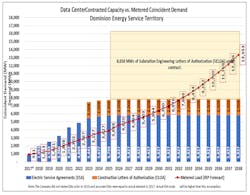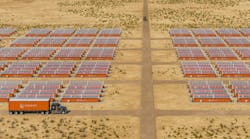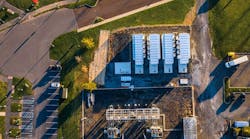Virginia is already the world’s largest market for cloud computing infrastructure. Despite the current power constraints around Ashburn, the data center market in Virginia is positioned to grow much larger.
Dominion Energy says it has received customer orders that could double the amount of data center capacity in Virginia by 2028, with a projected market size of 10 gigawatts by 2035. That represents a huge increase from current data center power use, which reached 2.67 gigawatts in 2022.
The utility’s projections mean that Virginia will continue to experience tensions between the growth of the Internet and the infrastructure to support it.
Everyone wants the Internet. But in Virginia, a growing number of residents are protesting the construction of new data centers – along with power lines to support them. And doubling the state’s data centers will require LOTS of new power lines.
What’s clear is that the data center industry remains eager to build in Virginia and can boost tax revenues in new areas of the state beyond Data Center Alley in Ashburn. Dominion Energy is a key player in whether it can realize that ambition.
Customers Ordering Ahead, at Scale
In recent testimony before state energy regulators, Dominion said its latest forecast for data center growth is supported by massive customer orders for power to support new projects, which include:
- 5,827 MWs of capacity with contracts to purchase electricity.
- 2,008 MWs of projects with construction underway on substations.
- 8,658 MWs of projects doing engineering studies for future data center campuses.
“The company’s data center forecast is informed and validated by existing contracts with customers that include financial commitments,” said Alan Bradshaw, the Vice President- Strategic Partnerships for Dominion Energy.
Anyone familiar with data centers will immediately recognize the magnitude of these contracts, as well as the infrastructure needed to make them a reality.
To support data centers’ appetite for power, Dominion has begun planning major upgrades to its transmission and substation infrastructure, submitting dozens of project proposals to the PJM Interconnection, which coordinates utility growth along the East Coast.
The potential for more data centers and power lines in Virginia is causing alarm among environmentalists and community groups, whose concerns include the cost of new power lines for ratepayers, their impact on communities, and Dominion’s plan to rely on natural gas generation to meet much of the additional demand.
The projections from Dominion underscore the enormous infrastructure needed to support the societal shift to digital services, especially online video and web applications. That growth is entering a new phase with the rise of artificial intelligence (AI) which is expected to require many new data centers.
“Data centers are the lifeline for our increasingly digitized world,” said Josh Levi, president of the Data Center Coalition. “Much of what we do in our daily digitized lives would not be possible were it not for data centers.”
The Home of the Cloud
Virginia has become the crossroads of the Internet, and a favored location for data centers and the power lines to support them. There are more than 250 data centers located in Northern Virginia, supporting Internet operations for Amazon, Google, Microsoft, Meta and Apple, among many others. The power capacity used by these data centers doubled between 2018 and 2022 to 2,767 megawatts of power, according to Dominion.
That growth offers many benefits. Data centers invested $6.8 billion in Virginia in 2021, supporting 45,460 jobs and paying out $3.6 billion in salaries, as well as $1 billion in tax revenues for local governments.
But the cloud cluster in Northern Virginia is experiencing growing pains, including power constraints in Loudoun County that will limit new construction in the next several years, and strong community resistance to data center development in Prince William County.
The power issues in Data Center Alley emerged from the rapid expansion of digital infrastructure to deliver online services during the COVID-19 pandemic. Dominion’s long-term forecast didn’t fully anticipate the sudden growth spurt, which outpaced its transmission capacity in several pockets of Eastern Loudoun County, delaying some data center projects until 2025 or 2026.
As a result, there’s heightened focus on Dominion’s data center forecast for future demand, and how it will expand its infrastructure to keep pace. That’s been the focus of the recent hearings at the Virginia State Corporation Commission (SCC), which regulates utilities.
Contracts Can Clarify Crystal Balls
Dominion has updated its methodology to extend its data center forecast from 5 to 15 years, and now includes more data to refine its projections. The longer timeline allows the utility to include the impact of long-term commitments from cloud builders, like Amazon’s recent pledge to invest $35 billion in data center infrastructure in Virginia between now and 2040.
The Dominion Integrated Resource Plan (IRP) came under scrutiny from clean energy advocates, who said the utility relies too heavily on fossil fuels for future power generation, instead of the renewable energy emphasized in the Virginia Clean Energy Act (VCEA). Dominion notes that it is investing nearly $10 billion an offshore wind farm, and last week announced a second offshore wind project.
Data centers occupy a central role in the debate. Community groups said the forecast didn’t account for future energy efficiency gains. Advanced Energy United, a trade association for the renewable energy sector, called Dominion’s data center forecasts “very aggressive.”
Dominion rebutted these critiques, sharing details on customer contracts and financial commitments, including nearly 6 gigawatts of service agreements and an even larger volume of projects in the construction and engineering phase.
Dominion Energy’s forecast included three types of contracts, which represent different stages of data center projects. “They do not overlap, and they are not double-counted,” said Dominion spokesman Aaron Ruby.
- Electric Service Agreements (ESA) are contracts for electrical service. “At this stage, a meter is set and electricity begins flowing,” said Ruby. Thus, the 5,827 MWs of ESA contracts are a highly reliable predictor of pending data center growth.
- Construction Letter of Authority (CLOA) is a contract to commence construction of substations and other facilities needed to deliver power. The customer is responsible for costs if the project is abandoned. A CLOA represents a meaningful commitment, as an average substation costs $25 million, Ruby said. Dominion has 2,008 MWs of CLOA agreements.
- Substation Engineering Letter of Authority (SELOA) is a contract to perform detailed engineering work for a customer project. “This is not a customer commitment to proceed, rather it provides detailed information to help a customer decide whether or not to proceed,” said Ruby. The customer is responsible for all engineering costs at this stage of the process.
The 8.6 GWs of SELOA contracts are slightly more speculative, as these are early-stage studies that may not always lead to new data centers. But they are a leading indicator of the expanding geography of cloud computing, as many of these contracts represent new projects in areas that lack existing data center infrastructure.
Gov. Glenn Youngkin supports the growth of the data center industry in Virginia, and hopes to expand the cloud boom beyond Northern Virginia, where the sector's explosive growth has sparked tensions with residents in Loudoun and Prince William counties.
Recent projects from Amazon Web Services (AWS) illustrate this trend. AWS recently confirmed plans to invest $11 billion in new cloud campuses in Louisa County, as well as four large data centers in Spotsylvania County and another in Culpeper County. All these projects are outside the existing cloud clusters in Northern Virginia.
Transmission Expansion Sparks Community Concern
To deliver the power for future data centers, Dominion Energy has submitted plans for extensive upgrades to its transmission network, including proposals for multiple 500 kV transmission lines to bring power to Northern and Central Virginia.
The PJM Interconnection says it has fielded 72 proposals to “address reliability needs … primarily associated with Data Center Load forecasts (up to 7,500 MWs by 2027-28).” PJM said 22 of the proposals were for upgrades, while 50 were “greenfield” projects for new power lines.
Not all the projects will be approved, but the sheer scope of the upgrades has alarmed community groups.
The Coalition to Protect Prince William County describes the PJM proposals as “cataclysmic and mind-boggling, bringing (new power lines) through and across the Eastern/MidAtlantic region, into our neighborhoods.”
The Coalition has shared a detailed analysis of the planned power line expansion on its web site. The group has sharpened its focus on the consequences of data center expansion on power infrastructure and its impact on quality of life.
“Virginia has to get a handle on this issue,” writes Julie Bolthouse, Director of Land Use for the Piedmont Environmental Council, a local environmental group. “We are working to shine a light on the explosive growth of the data center industry and pushing for more research, better planning, greater oversight, and appropriate mitigation when negative consequences can’t be avoided.”
An interesting wrinkle: Dominion says its estimates reflect contracts through July 2023, and could underestimate future demand related to AI.
“The company’s current data center load forecast does not fully integrate the potential impact of these new technologies because more data is needed,” said Bradshaw. “However, it is clear that the evolution of AI and other technologies are real and will drive further, or at a minimum sustain existing, growth in the data center industry.”
Keep pace with the fast-moving world of data centers and cloud computing by connecting with Data Center Frontier on LinkedIn, following us on X/Twitter and Facebook, and signing up for our weekly newsletters using the form below.







